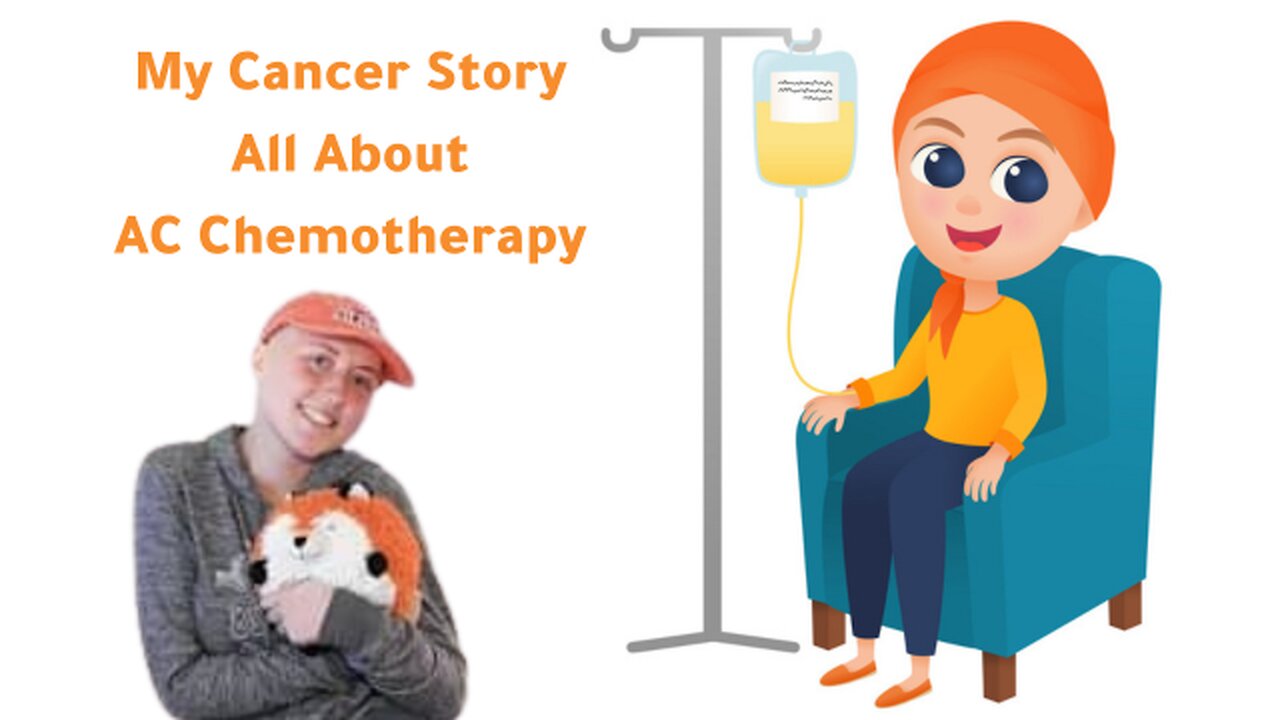Premium Only Content

My Cancer Story : All About AC Chemotherapy
Hello, it's Samantha again and I'm here with another awkward introduction. If you clicked on this video, you probably read the title and decided you want to watch it. I hate me. I'm going to be explaining all about a C chemotherapy. I have no idea what that stands for. I'm going to Google it real quick. It's not air conditioning. It's not alternating current cyclo.
Close. How do you say this? I'm gonna Google how to say this. Cyclophosporide sag Sag, cyclosite, cyclophospide from my cyclophosporide cyclophosphamide. Cyclophospor A/C stands for adriamycin and cyclophosphamide. I'm going to be explaining what happens when you get it.
The side effects that I had, yeah, and probably some other stuff that I can't think of right now. So I already finished my A/C chemotherapy. I had four rounds of it, so I don't have a full on blog, but I've got lots of videos and pictures of everything. April 5th was my first treatment and I did it every other week from then. It's basically a typical day for me arrive at the Cancer Center. It took me like probably a full month of going there.
To stop laughing at the name because it just sounds really serious. I would get my stylish bracelet that has my name and my birthday on it. I would wait in the waiting room until they were ready. Then I would go back by myself and they would access my port. It's just a medical device that is in my body. They did surgery to put it in so it's under the skin and they stick it.
To give me my chemotherapy. It's just so that they don't have to give me an IV and my hand or my arm every time because the chemotherapy would tear up my veins in my arm. So if it goes through the port, it gets directly pumped out through bigger veins and stuff that can handle it. But what they do when I go back there is that they just take some blood so that they can send it to the lab and they can check and make sure that everything looks OK Then I go away in the waiting room a little bit longer and then I go meet with my.
Oncologist Every week the nurse asks me a bunch of questions about how I'm doing on the chemo and my side effects and everything. And then she asked my stress level. And I always say it's great because I think that's a dumb question. And then they just measure the bump.
In my breast and check to see if it's gotten any smaller. Mine did get smaller. It started out 3.5 by 3.5 centimeters. By the 3rd treatment I think it was 2.5 by 2.5. So after my checkup I go and I find a place to sit. Usually like to try to find a heated chair because I get cold easily they have to do a few things before they start giving me the chemo. In the checkup they check my height and weight.
I don't really know why they need to keep checking my height because I'm done growing. The amount of chemo that they gave me is very dependent on my height and weight. For instance, on the first day that I went, I had a lot of extra weight leftover from my egg retrieval surgery for the adriamycin. They had two big syringes of it. They had one tiny little syringe. They all were joking about how it was really funny that there was like this tiny little syringe with a little bit of medicine. Then the second day I came in for chemo.
I had lost £5 by then because I was just going back to my regular weight and that extra little syringe was gone. They didn't use it at all, so it really doesn't matter how much they give you based on your weight. Even like £2.00 can make a small difference. Anyway, I go and sit in the chair and before they can even give me the chemo, they have to give me nausea medicine. Some of the nausea medicine is pills.
And some of the nausea medicine, they pump directly in through my port, they get the medicine from the pharmacy. They start with the Adriamycin. It is very red. They can't just put that on the little machine to pump directly in through my port because it's very important that someone, a nurse, is there to watch it being put in and it is important for them to keep checking as they're putting it in if there is blood coming back.
So they push the red medicine in and then they pull back and they make sure that they're still getting blood return. It can cause severe, severe burning if it doesn't go directly into the veins. The nurse also needs to wear a huge cover and protect themselves while they're injecting this into me because if any of it gets on them, they saw that it caused bladder cancer, so.
This is not normal medicine. It's a little bit scary. They're basically just putting poison into you. Also, because of that red color, it afterwards turns all your bodily fluids red. Your urine will be red, basically bright red the very first time you'd pee. And then after that it starts fading a bit away, gets like orange, and then this is really gross.
Starts turning back to the regular color as the week goes on. It's supposed to do like, all your fluids. So somebody said that they tried to cry to see if their tears would be red. I don't know if they were successful. I don't know. So if you're doing this, that could be something to try. OK, so after they drew my sin, they have to do the other one. And I'm not going to try to pronounce it again. And that one can just go straight up on the machine. I guess they do it over 30 minutes usually. I only did it over 30 minutes.
The first time I went in because that one can cause your nose to start burning. There's probably the last 10 minutes of getting the medicine that I actually noticed it and my nose just kind of started burning like in the inside. After a while, it started like going up into my head and I like felt like my brain was burning, if that makes sense.
It just caused a headache. By the end I only had like 2 more minutes of it. I was like, all right, just keep going, I'll make it through. What helped me was instead of going over 30 minutes, the next time they did it over a full hour, I still every single time felt the burning. But it was only in that like last five or 10 minutes. So I feel it so usually just pushed through and it was never as bad as the first time. It never caused the full on headache, the headache and everything completely went away after 20 minutes. So it's not like it causes permanent.
Damage or anything. While they are giving the second infusion, they attach a Neulasta patch. They put it on my arm, they can put it in your stomach or basically wherever you're comfortable. After they put it on, it starts beeping. It tells you that it's going to stick you, it makes this a whacking noise and then it injects the little tube thingy, I guess.
-
 LIVE
LIVE
Steven Crowder
2 hours ago🔴 Total Failure: Unpacking The Media's Evil Reaction to the Minneapolis Church Shooting
56,307 watching -
 LIVE
LIVE
Right Side Broadcasting Network
2 hours agoLIVE: White House Press Secretary Karoline Leavitt Holds a Press Briefing - 8/28/25
2,092 watching -
 LIVE
LIVE
Nikko Ortiz
36 minutes agoLive - Reaction Time, News, Politics, and More!
223 watching -
 1:02:26
1:02:26
VINCE
2 hours agoTragedy In Minneapolis | Episode 113 - 08/28/25
65.3K93 -
 LIVE
LIVE
Reidboyy
30 minutes agoHow To Make $$$ in Delta Force Console Operations!
46 watching -
 LIVE
LIVE
JuicyJohns
3 hours ago $0.26 earned🟢#1 REBIRTH PLAYER 10.2+ KD🟢
64 watching -
 LIVE
LIVE
Major League Fishing
6 days agoLIVE! - Fishing Clash Team Series: Challenge Cup - Day 5
143 watching -
 LIVE
LIVE
LFA TV
4 hours agoLFA TV ALL DAY STREAM - THURSDAY 8/28/25
5,085 watching -
 LIVE
LIVE
Total Horse Channel
14 hours ago2025 URCHA Futurity | Derby & Horse Show | Thursday
104 watching -
 LIVE
LIVE
The Big Mig™
1 hour agoThe War Powers Resolution w/ David Clements
5,163 watching